Keto Diet Full Fat Dairy
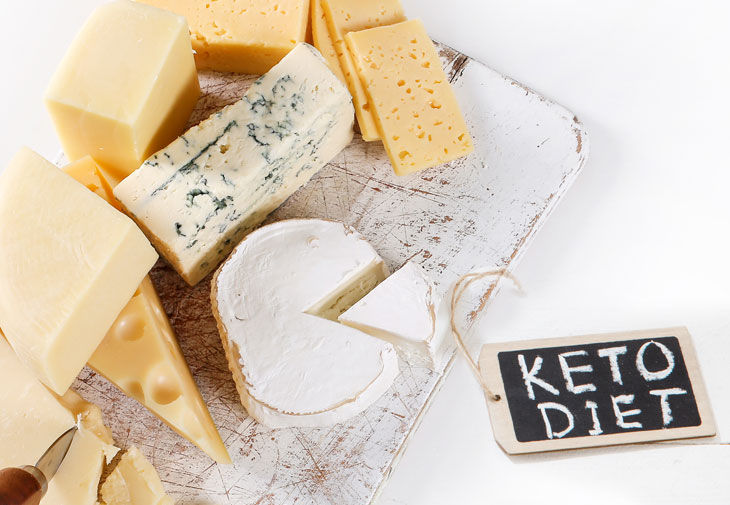
You've finally decided to try the keto diet. Or you're planning on giving it a try. Whatever stage you're at, you might be wondering whether you'll have to give up dairy products. Fortunately, you don't have to.
For starters, the keto diet involves a much lower amount of carbohydrates with more protein and healthy fats. This means that you'll have to find some full-fat and low-carb dairy products to switch to in order to stay in line with this diet.
Such keto-friendly dairy products can help to limit inflammation, improve the body's composition, encourage weight loss and also protect against heart disease-related conditions.
Nevertheless, it is important to experiment with small amounts during your ketogenic diet and find the right balance for you. Dairy products don't always affect people the same way and there is still more research to be done on their effects while on a keto diet.
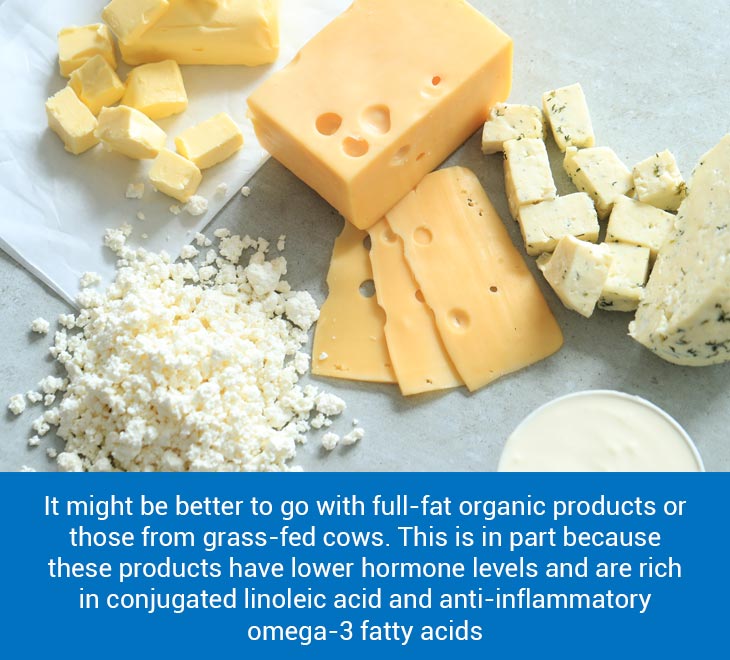
Here is a list of common dairy products and other dairy-rich foods to consider when you're following a keto diet:
Fewest grams of carbohydrates per ounce (28 grams):
- Butter (0.1g for 2 tablespoons)
- Muenster cheese (0.3g)
- Brie and Camembert cheese (0.1g)
- Gouda cheese (0.6g)
- Cheddar cheese (0.4g)
- Mozzarella cheese (0.6g)
- Cream (0.8g for 2 tablespoons)
- Bleu cheese (0.7g)
- Cream cheese (1.1g)
- Sour cream (1g for 2.5 tablespoons)
- Swiss cheese (1.5g)
More grams of carbohydrates (these amounts are measured per 3.5 ounces or 100 grams):
- Ricotta cheese (3g)
- Plain greek yogurt (2-4g, mainly depending on the level of fermentation)
- Cottage cheese (3.4g)
- Paneer (4.1g)
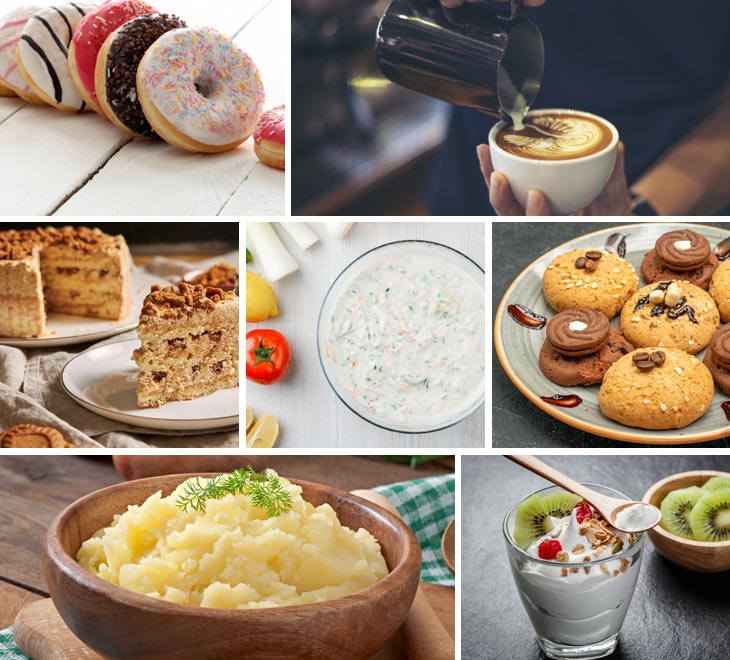
Foods with milk in them:
- Donuts
- Coffee creamers
- Cake mix
- White sauces
- Margarine
- Nougat
- Sherbet
- Baked snacks (cakes, cookies, bread, etc.)
- Creamed and scalloped foods
- Mashed potatoes
- Chewing gum
- Au gratin dishes
Ingredients with milk
- Caseinates
- Ghee
- Curd
- Hydrolysates
- Artificial butter and cheese flavoring
- Whey products
- Rennet
- Lactose and lactulose
- Lactalbumin and lactalbumin phosphate
- Lactoglobulin and lactoferrin
- Malted milk
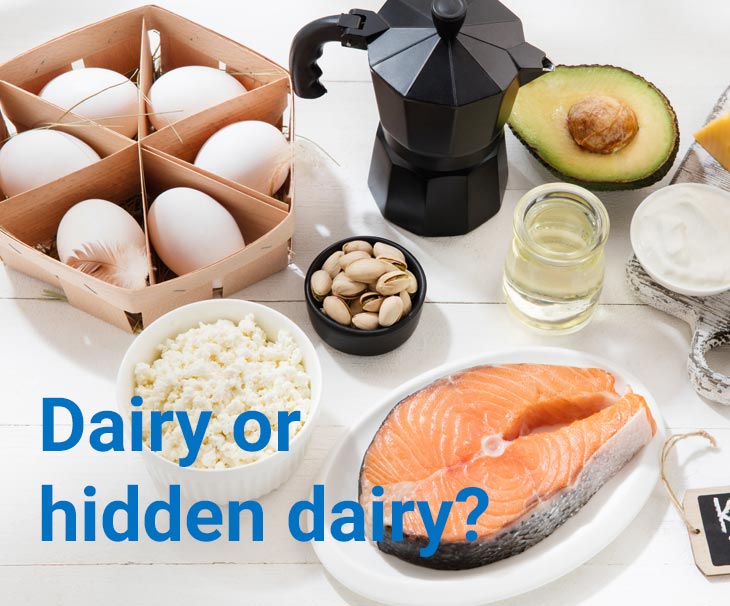
How to tell if a product has dairy or hidden dairy
If you're going to be consuming dairy while on a keto diet, it is important to know how to identify products with hidden dairy. This is particularly helpful when it comes to staying within the recommended number of servings.
First, let's look at a list of products that aren't always easily identifiable as dairy-free:
- Chewing gum – Some types of chewing gum are made with an additive known as Recaldent, which is made from milk. Be on the lookout for any packaging that lists this ingredient.
- Sherbet – Contrary to what some may believe, sherbet is actually made with milk and isn't really a sorbet. It is more of a fruity ice cream.
- Croutons and bread crumbs – Bread crumbs and croutons sold in stores usually have milk as one of their ingredients. Panko and cornflake crumbs may be better alternatives, but it's vital to always read the full list of ingredients.
- Processed meats – From deli meat to hot dogs, there are many kinds of processed meat that contain whey or another milk-based ingredient or milk derivative. This usually serves as filler. For example, cheese is added to some premium sausages.
- Canned fish – Many brands of canned fish have some milk included, even though it may not be listed as one of the ingredients.
- Bread – It is quite common in the baking world for bread dough to be fortified with milk or even butter. This practice is even more prevalent in the cases of sweeter breads like brioche as well as with dinner rolls. Luckily, it is not hard to find bread without milk in it.
- Lactose-free products – This category is particularly important for people allergic to casein or some other component of milk. Many products marked "lactose-free" are usually just like ordinary dairy products, but they contain the lactase enzyme.
This approach could actually be helpful to lactose-intolerant people.
- Bouillon – Beef bouillon may contain milk or, more specifically, the component whey as a filler. The same goes for many gravy mixes. Try choosing loose bouillon instead of the cubes.
- Medication – Ensure that you always check the labels on your medication for ingredients like whey or lactose.
- Spice blends – While many cajun and pumpkin pie spices are dairy-free, some brands of taco seasoning and ranch mix contain whey or milk powder.
- Instant potatoes – These usually have dried milk and butter flavoring added.
- Granola and cereal bars – Many of these are made with butter or whey powder for additional flavor.
- Chips – Products like salt and vinegar chips and other kinds of snacks may have whey added to make them creamier and boost their flavor.
- Salad dressings – Whether it's ranch dressing or vinaigrettes, there's a good chance that milk ingredients are present. However, you can always make your own with minimal or zero dairy.
- Alcohol – Some beer-brewing and wine-making processes include the use of milk derivatives. Other types of alcoholic products like liqueurs may contain cream as a major ingredient. In many regions, manufacturers of these products aren't mandated to indicate their ingredients on the labels.
This makes it a little bit trickier to identify alcoholic products with dairy, especially those where it's merely used in preparation and not really as a front-and-center ingredient.
- Margarine – Especially when it comes to margarine brands marketed as substitutes for butter, you may find that they have whey added to make them taste more like butter.
- Crackers – While some may contain cheese, other brands usually have milk as one of their ingredients.
- Breath mints – Some breath mints contain casein-related ingredients.
- Whipped toppings – Be cautious with a lot of dessert packages that are labelled "non-dairy topping." Many of them contain casein.
- Soy cheeses – Even though they are often touted as healthier alternatives to regular milk products, many soy cheese products have milk proteins added so that they can better emulate regular cheese.
- Peanut butter – Some brands contain milk solids.
- Imitation maple syrup – It's much better to go for real maple syrup or whatever other kind of syrup you're looking for instead of their knock-off versions. Products that attempt to mimic these syrups are usually not dairy-free.
- Meal replacement drinks/beverages and protein powders – A lot of the mixes and shakes that are said to offer the equivalent of a full meal or balanced diet may contain milk powder and other ingredients derived from milk.
- "Soy meat" or veggie options – Burger patties, sausages and hot dogs sold as meat substitutes for vegans may contain milk protein.
- Fried foods – Sometimes these foods are prepared with additional cheese and could contain milk protein, especially in their breading.
- Fat replacers – Some fat replacer brands like Simplesse and Dairy-Lo are made from milk.
- Eggnog – Try making your own eggnog or opting for soy-nog if you're sure about how it's made/what it's made with.
- Artificial sweeteners – For those who don't like using sugar when baking, making juice or other dishes that should come out sweet, stay vigilant. Some sweeteners are derived from dairy foods.
- Caramel and candy – Caramel is commonly made from heated sugars but may contain milk protein in some cases where the maker is pursuing a less generic taste.
- Chocolate drinks – Non-milk varieties may occasionally have a hint of dairy to spruce them up.
Others include cereal, custard/pudding, chicken broths, fondue, soup, cocoa mix, ghee, etc.

Now that we have a list of products that may have hidden dairy, let's break down a few ways to identify these products:
- Use barnivore.com. It's a good online resource for people who want to know whether a product is vegan-friendly (dairy-free).
- Look out for the label "Parve" or "Pareve." This means that the product is dairy-free. This also applies to products with a circled "U" on them.
- A "D" or "DE" placed next to a circled "U" or "K" may mean that the product contains milk protein.
- Take note of the workflow in certain kitchens and serving areas when possible. Pay attention to details like whether they use the same utensils to cut/dice/wedge dairy foods as they do for other foods. The same goes for chopping boards, bowls, etc.
It is possible to pick foods that are dairy-free only to end up still consuming dairy because they were contaminated during handling.
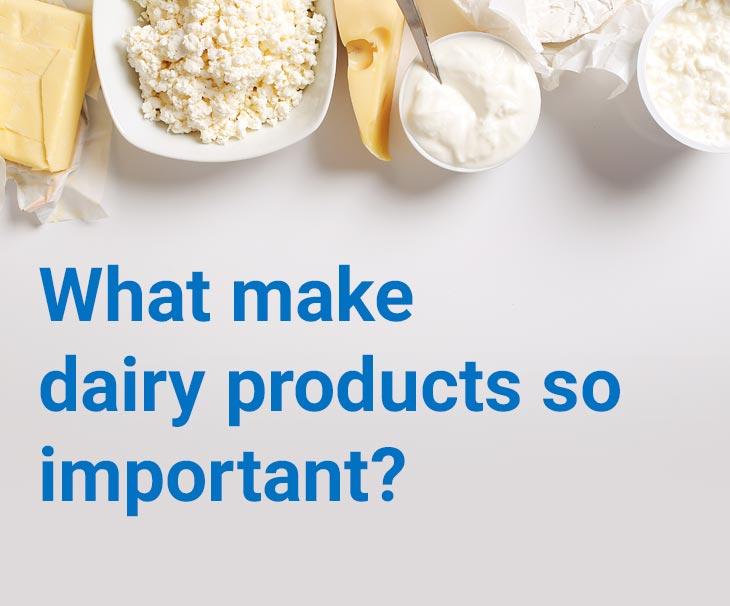
So what is it about dairy products that makes them so important?
Dairy products refer to just about any beverage or food that is partly or wholly made from the milk of mammals (commonly cows, goats and sheep).
They contain lactose (a two-unit sugar from which glucose is derived), casein (which makes up 80% of the total protein in these products) and the nine essential amino acids. Whey accounts for the other 20% of the protein.
They also contain fatty acids, with the saturated ones taking up 70% of the total fat, monounsaturated acids making up 25% and polyunsaturated acids accounting for the remaining 5%. Dairy foods are also great sources of calcium.
How much dairy do you need per day?
Firstly, one should opt for low-fat dairy products and take no more than three servings (3 cups) per day. For children, the amount may vary from two to two-and-a-half servings per day depending on their age. Examples of servings can include:
- 1 cup of 2%, 1% or skim milk
- 1 cup of yogurt
- ½ cup of cottage cheese
- An ounce of cheddar cheese
For some other low-fat dairy substitutes, try:
- Rice milk, almond milk or fortified soymilk
- Dairy Ease, Lactaid and other related products, for those who are lactose-intolerant
Advantages of consuming dairy while on a keto diet
A keto diet with low-carb dairy products in small amounts can support weight loss, especially in the beginning. Such a diet helps one to get rid of excess water from the body, reducing insulin levels and speeding up weight loss in the first two weeks.
- This approach can help you reduce visceral fat that usually collects around body organs and is commonly linked to inflammation, insulin resistance and also leads to metabolic dysfunction.
- In the long run, the low-carb conditions could also limit the risk of type 2 diabetes and heart disease.
- An increase in the levels of high-density lipoprotein (HDL), also known as good cholesterol. Common in diets rich in fat, HDL can reduce the risk of heart disease when it remains higher than LDL.
- Dairy also contains calcium, which helps strengthen the bones.
- Eating dairy while on a keto diet can also go a long way in moderating appetite. This is more likely if you're consuming low-carb dairy products to keep your carbohydrate intake low.
- For people with hypertension, consuming low-carb dairy in combination with a keto diet can help lower blood pressure. This subsequently limits the risk of kidney failure, a stroke and even heart disease.
- A reduction in triglycerides (fat molecules) within your blood.
- Dairy can help to reduce the level of cortisol, a stress hormone that can increase abdominal fat storage.
Disadvantages of consuming dairy while on a keto diet
- Dairy can have adverse effects on people who are allergic to casein or are lactose-intolerant. Cheese and yogurt may contain less lactose, but they can still be harmful to some people.
- It can increase the risk of hormone-receptive breast cancer, prostate cancer and other hormone-sensitive cancers due to the estrogen levels. You may be able to switch to goat milk products since it has less estrogen. In that case, keep the servings to one or less a day.
- Full-fat dairy may be hard to resist, leading to a situation where you're taking in too much fat and slowing any progress in the overall health of your body.
Some tips to remember
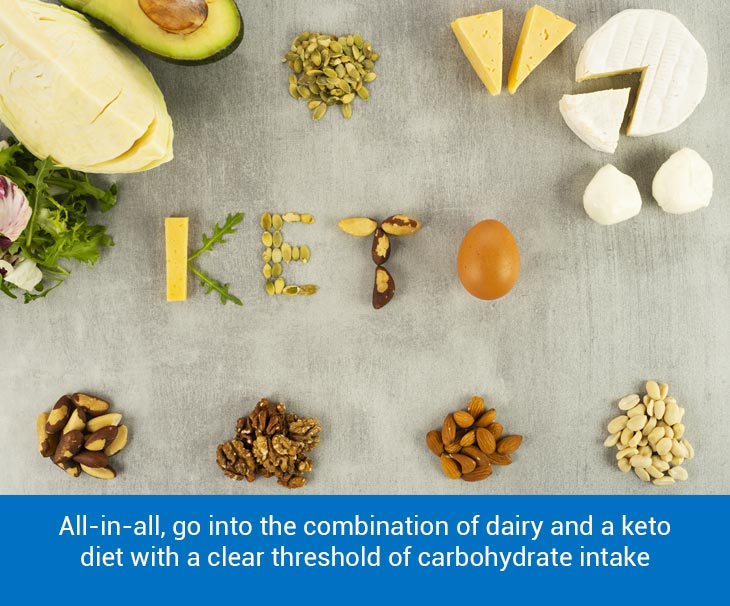
Many dairy products are known to raise insulin levels so as to get amino acids into the muscles, which could conflict with the whole state of ketosis. However, when it comes to adults, the protein in milk and other dairy foods may not always increase insulin as much as some other protein-rich foods.
All in all, go into the combination of dairy and a keto diet with a clear threshold of carbohydrate intake and pay close attention to the ingredients and their amounts in every product you buy.
Stick to the servings you set and don't try to randomly substitute foods (e.g. saying that you'll do a little more dairy because you didn't consume as much fatty foods as you should have on a given day). Don't tweak the formula without concrete data indicating a need to do so.
If possible, consult a dietician or some other qualified medical practitioner to find out any characteristics unique to you that could make the normally healthy/recommended amounts of milk protein, lactose and fats detrimental to your health.
Source: https://milkyday.com/blog/2021/05/01/what-dairy-products-are-keto-friendly/